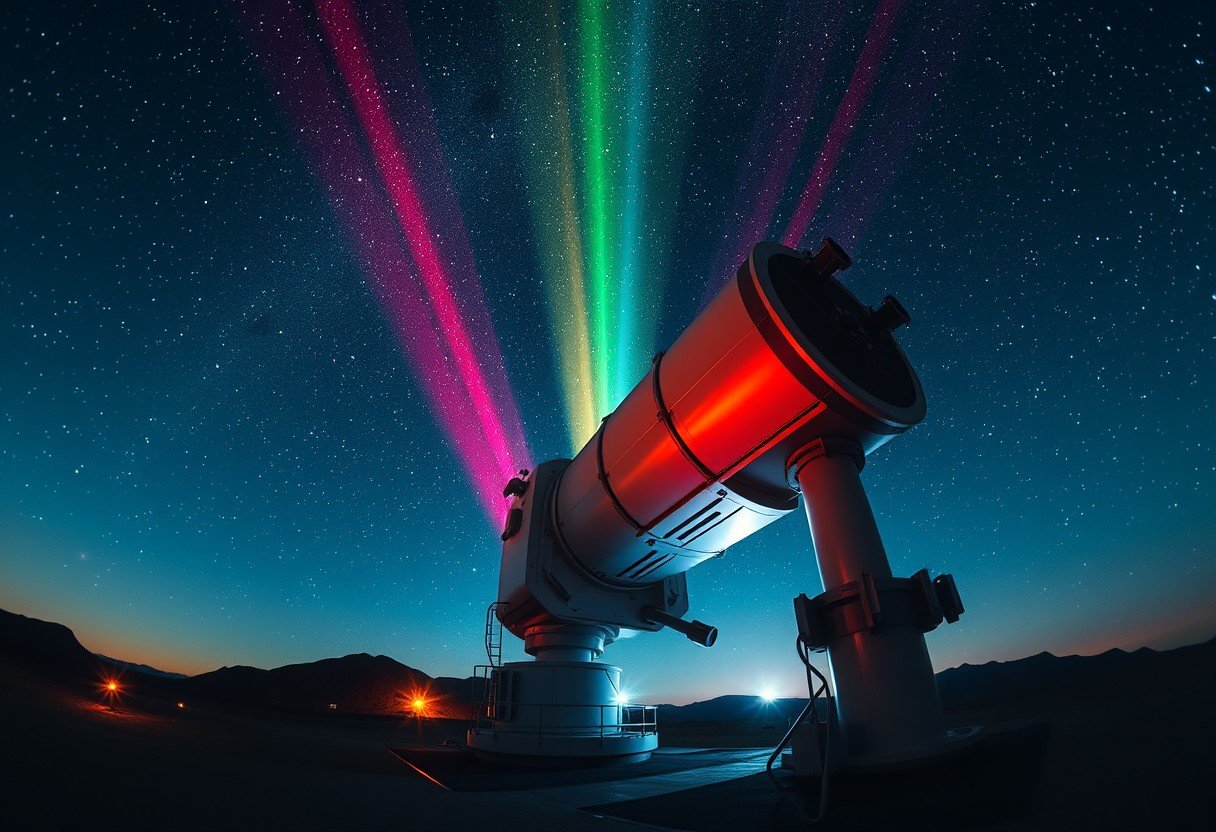The biggest telescopes on Earth are engineered to capture different segments of the electromagnetic spectrum, each offering a window into the universe’s secrets. Understanding which wavelengths these observatories target, and why, reveals how astronomers study distant stars, galaxies, and cosmic phenomena. Explore how these advanced instruments operate and what they uncover about space.
Understanding the Electromagnetic Spectrum in Astronomy
The electromagnetic spectrum includes all types of light, from long-wavelength radio waves to short-wavelength gamma rays. Each section of this spectrum carries unique information about the universe. By observing different wavelengths, astronomers are able to study a variety of cosmic events and physical processes that would otherwise remain hidden.
Electromagnetic radiation travels through space as energy waves, produced by moving charged particles. The spectrum stretches from radio waves (with wavelengths up to kilometers) to gamma rays (with wavelengths smaller than a trillionth of a meter). This broad range enables scientists to examine everything from massive galaxy clusters to the smallest subatomic particles.
- Visible light reveals stars and galaxies in detail.
- Infrared waves penetrate dust to uncover hidden regions of star formation.
- Radio waves map cosmic structures and study phenomena like pulsars and quasars.
Different wavelengths are blocked or altered by Earth’s atmosphere, so telescope placement and design are crucial. By combining observations across the spectrum, astronomers develop a more complete picture of the universe’s structure and history.
Optical Telescopes: Unlocking the Visible Universe
Optical telescopes are among the most recognized and widely used tools in astronomy. They operate mainly in the visible spectrum, gathering light that ranges from about 400 to 700 nanometers. This is the same range that the human eye detects, making optical telescopes essential for both research and public outreach.
By collecting and focusing visible light, these telescopes allow astronomers to observe planets, stars, nebulae, and galaxies in remarkable detail. Thanks to innovations like adaptive optics and advanced detectors, modern optical telescopes can capture images that reveal faint and distant objects with high clarity.
Some of the largest and most advanced optical telescopes include:
- Keck Observatory (Hawaii): Features two 10-meter mirrors, offering high-resolution imaging and spectroscopy.
- Gran Telescopio Canarias (Spain): The world’s largest single-aperture optical telescope with a 10.4-meter mirror.
These powerful instruments have enabled discoveries such as the identification of exoplanets, detailed mapping of galaxies, and the study of supernovae. Their contributions are crucial for understanding the universe’s structure and evolution.
Radio Telescopes: Probing the Invisible Cosmos
Radio telescopes capture radio waves from space, allowing astronomers to explore regions of the universe that are invisible to optical telescopes. Operating at wavelengths from about 1 millimeter to 10 meters, radio telescopes can detect signals from cosmic sources that are otherwise obscured by dust or distance.
Their large dish antennas collect faint radio emissions from objects such as pulsars, quasars, and the cosmic microwave background. Because radio waves can pass through clouds of dust and gas, radio telescopes offer a unique perspective on the structure and dynamics of galaxies and star-forming regions.
Notable examples of large radio telescopes include:
- Very Large Array (VLA, New Mexico): Made up of 27 antennas, each 25 meters wide, the VLA acts as a single, powerful instrument for high-resolution imaging.
- Arecibo Observatory (Puerto Rico): Once the largest single-dish radio telescope, Arecibo contributed to planetary radar studies and the search for extraterrestrial intelligence before its collapse in 2020.
Radio telescopes have provided evidence for black holes, mapped the structure of the Milky Way, and enabled the discovery of fast radio bursts and other mysterious cosmic signals.
Infrared and Ultraviolet Telescopes: Revealing Hidden Realms
Infrared and ultraviolet telescopes extend our vision beyond visible light, allowing astronomers to investigate phenomena not detectable with traditional optical instruments. Infrared telescopes observe wavelengths just longer than visible light, from about 700 nanometers to 1 millimeter. Ultraviolet telescopes focus on shorter wavelengths, from about 10 to 400 nanometers.
Infrared observations are especially valuable for studying cool objects like newly forming stars, exoplanets, and distant galaxies shrouded in dust. High-altitude or space-based sites are often required, since water vapor and heat from Earth’s atmosphere can interfere with infrared signals.
Key examples in this field include:
- Very Large Telescope (VLT, Chile): Uses adaptive optics to achieve sharp infrared images of distant galaxies and stellar nurseries.
- Hubble Space Telescope: Performs both infrared and ultraviolet observations, uncovering details about star formation, galaxy evolution, and the chemical composition of the universe.
Ultraviolet telescopes, often located in space, reveal energetic processes like star birth, supernovae, and the behavior of hot, young stars. Together, infrared and ultraviolet astronomy provide critical data for understanding the lifecycle of stars and galaxies.
X-ray and Gamma-ray Telescopes: Exploring Extreme Phenomena
Some of the most energetic and mysterious events in the universe emit X-rays and gamma rays. Telescopes designed to observe these high-energy wavelengths are typically placed in space, since Earth’s atmosphere absorbs most X-rays and gamma rays before they reach the ground.
By detecting these powerful emissions, astronomers can study black holes, neutron stars, supernova remnants, and gamma-ray bursts. These observations reveal information about the physics of matter under extreme conditions and the life cycles of the most massive stars.
Major telescopes in this category include:
- Chandra X-ray Observatory: Provides detailed images of X-ray sources, revealing the structure and behavior of supernova remnants and black hole accretion disks.
- Fermi Gamma-ray Space Telescope: Detects gamma rays from phenomena such as pulsars and cosmic explosions, helping to map the high-energy universe.
These observatories have expanded our understanding of how energy and matter interact in the cosmos and continue to uncover new, unexpected phenomena.
Comparing Telescope Types and Their Scientific Contributions
Each type of telescope is tailored for a specific range within the electromagnetic spectrum. By comparing their functions, we can better understand their unique contributions to astronomy and why a multi-wavelength approach is essential.
| Telescope Type | Wavelength Range |
|---|---|
| Optical Telescopes | 400 – 700 nm (visible light) |
| Radio Telescopes | 1 mm – 10 m (radio waves) |
| Infrared Telescopes | 700 nm – 1 mm (infrared) |
| X-ray Telescopes | 0.01 – 10 nm (X-rays) |
Optical telescopes deliver high-resolution images of galaxies and nebulae. Radio telescopes map large-scale cosmic structures and detect faint signals from deep space. Infrared telescopes reveal star-forming regions hidden by dust, while X-ray and gamma-ray telescopes unlock the energetic processes behind cosmic explosions and black holes.
This diversity allows astronomers to piece together a more complete story of the universe, from its origins to its most extreme events.
Challenges and Advances in Multi-Wavelength Astronomy
Observing across the electromagnetic spectrum is not without challenges. Earth’s atmosphere can block or distort many wavelengths, requiring telescopes to be placed at high altitudes or in space. For example, water vapor and heat from the ground affect infrared observations, while X-rays and gamma rays are almost completely absorbed before reaching the surface.
Technological advancements have greatly improved telescope performance. Adaptive optics correct for atmospheric distortion in real time, enabling clearer images from optical and infrared telescopes. New materials and sensors have increased sensitivity across all wavelengths, allowing astronomers to detect fainter objects and finer details than ever before.
- High-altitude observatories, like those in Chile and Hawaii, minimize atmospheric interference.
- Collaborations between observatories worldwide combine data across wavelengths for a more comprehensive analysis.
International partnerships have also led to the sharing of data and resources, maximizing the scientific return from each instrument. The combination of ground-based and space-based observatories ensures that astronomers can probe the universe from many angles, enhancing discovery and understanding.
Conclusion
In summary, Earth’s largest telescopes operate throughout the electromagnetic spectrum, with most focusing on the visible, infrared, and radio wavelengths. Each telescope type brings unique insights into the universe, from mapping galaxies and detecting cosmic background radiation to exploring black holes and star formation. Understanding how these instruments work and what wavelengths they observe is key to appreciating the full scope of astronomical research. Whether you are an aspiring astronomer or a curious learner, knowing the strengths of each telescope enhances your exploration of the cosmos.
FAQ
What parts of the electromagnetic spectrum do the biggest telescopes observe?
Most large telescopes on Earth operate in the visible and infrared parts of the spectrum. Some, like radio telescopes, observe radio waves. Space-based telescopes extend coverage to ultraviolet, X-rays, and gamma rays.
Why are infrared and radio observations important in astronomy?
Infrared and radio waves can penetrate dust clouds that block visible light, revealing hidden regions of star formation and galactic structures. These observations help astronomers study the early universe and discover new objects.
How does Earth’s atmosphere affect telescope observations?
The atmosphere absorbs and distorts certain wavelengths. Visible light mostly passes through, but infrared, ultraviolet, X-rays, and gamma rays are blocked or altered. This is why many telescopes are located on high mountains or in space.
Are there telescopes that observe more than one wavelength?
Yes. Some advanced telescopes, like the Hubble Space Telescope and the Very Large Telescope, are equipped to observe multiple wavelengths, including visible, infrared, and ultraviolet. This multi-band capability provides more data for analysis.
What technological advances have improved telescope performance?
Adaptive optics, advanced sensors, and international data sharing have all improved telescope capabilities. These advances allow astronomers to capture clearer, more detailed images and combine information from different wavelengths for a deeper understanding of the universe.









Leave a Comment